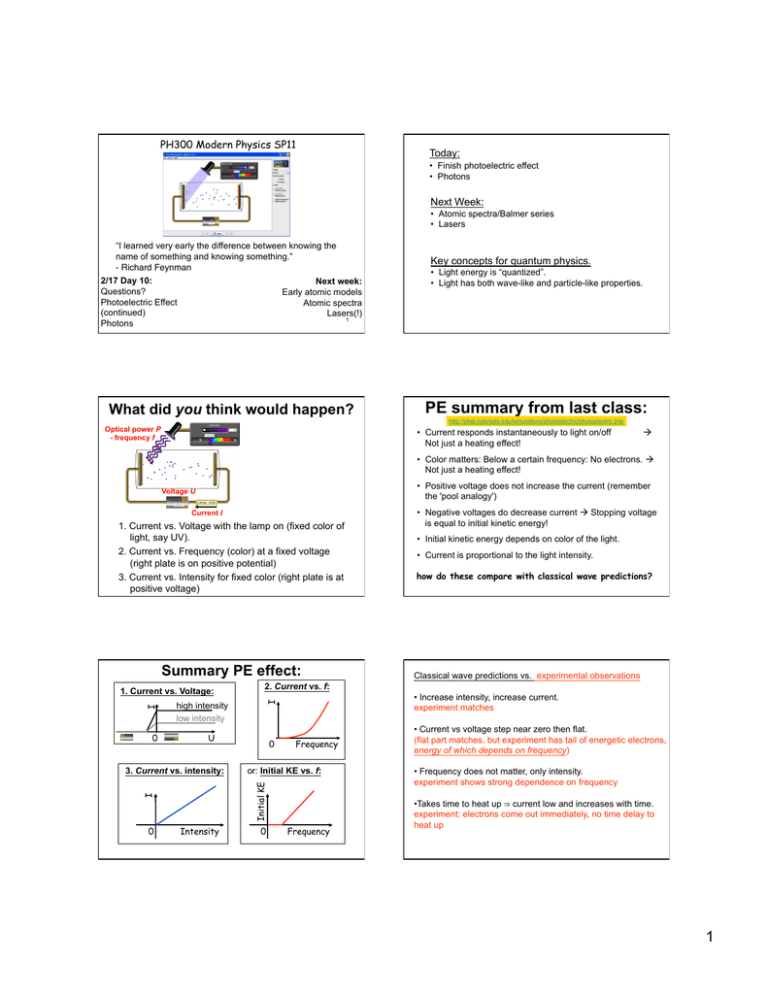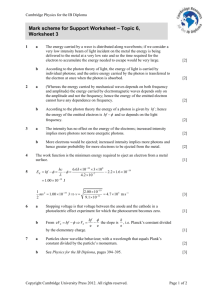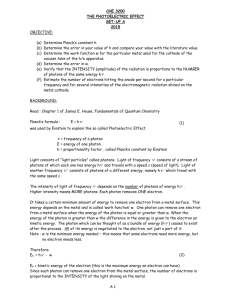PE summary from last class:
advertisement

PH300 Modern Physics SP11 Today: • Finish photoelectric effect • Photons Next Week: • Atomic spectra/Balmer series • Lasers “I learned very early the difference between knowing the name of something and knowing something.”! - Richard Feynman 2/17 Day 10: Next week: Questions? Early atomic models Photoelectric Effect Atomic spectra (continued) Lasers(!) 1 Photons What did you think would happen? Key concepts for quantum physics. • Light energy is “quantized”. • Light has both wave-like and particle-like properties. PE summary from last class: http://phet.colorado.edu/simulations/photoelectric/photoelectric.jnlp Optical power P - frequency f • Current responds instantaneously to light on/off Not just a heating effect! à • Color matters: Below a certain frequency: No electrons. à Not just a heating effect! • Positive voltage does not increase the current (remember the 'pool analogy') Voltage U Current I 1. Current vs. Voltage with the lamp on (fixed color of light, say UV). 2. Current vs. Frequency (color) at a fixed voltage (right plate is on positive potential) 3. Current vs. Intensity for fixed color (right plate is at positive voltage) Summary PE effect: 0 high intensity low intensity U I 0 Intensity • Current is proportional to the light intensity. how do these compare with classical wave predictions? Classical wave predictions vs. experimental observations • Increase intensity, increase current. experiment matches 0 Frequency or: Initial KE vs. f: Initial KE 3. Current vs. intensity: • Initial kinetic energy depends on color of the light. 2. Current vs. f: I I 1. Current vs. Voltage: • Negative voltages do decrease current à Stopping voltage is equal to initial kinetic energy! 0 Frequency • Current vs voltage step near zero then flat. (flat part matches, but experiment has tail of energetic electrons, energy of which depends on frequency) • Frequency does not matter, only intensity. experiment shows strong dependence on frequency • Takes time to heat up ⇒ current low and increases with time. experiment: electrons come out immediately, no time delay to heat up 1 Summary of what we know so far: 1. If light can kick out electron, then even smallest intensities of that light will continue to kick out electrons. KE of electrons does not depend on intensity. 2. Lower frequencies of light means lower initial KE of electrons & KE changes linearly with frequency. Kicker analogy: a ball in a pit Light like a Kicker… Puts in energy. All concentrated on one ball/electron. Blue kicker always kicks the same, and harder than red kicker always kicks. Ball emerges with: KE = kick energy - mgh mgh = energy needed to make it up hill and out. mgh for highest electron analogous to work function. 3. Minimum frequency below which light won’t kick out electrons. (Einstein) Need “photon” picture of light to explain observations: - Light comes in chunks (“particle-like”) of energy (“photon”) - a photon interacts only with single electron - Photon energy depends on frequency of light, … for lower frequencies, photon energy not enough to free an electron Kick energy. Top ones get out, bottom don’t. Harder kick (shorter wavelength light), more get out. electrons metal Kicker analogy: a ball in a pit Light like a Kicker… Puts in energy. All concentrated on one ball/electron. Blue kicker always kicks the same, and harder than red kicker always kicks. If photon has enough energy, electron emerges with: KE = photon energy – work function Ball emerges with: KE = kick energy - mgh mgh = energy needed to make it up hill and out. mgh for highest electron analogous to work function. h energy needed to kick out least bound electron. “WORK FUNCTION” (Φ) Each photon has: Energy =h f = Planks constant * Frequency (Energy in Joules) E=hf=(6.626*10-34 J-s)*(f s-1) E=hc/λ = (1.99*10-25 J-m)/(λ m) h (Energy in eV) E=hf= (4.14*10-15 eV-s)*(f s-1) E= hc/λ = (1240 eV-nm)/(λ nm) Initial KE of electron = Ephoton - energy needed to kick as it comes out of metal electron out of metal sodium- easy to kick out small work function Φ = shallow pit platinum, hard to kick out large work function Φ = deep pit Photon Energies: Photon… Puts in kick of energy Depends on type of metal. Typical energies KE300 Each photon has: Energy =h f = Planks constant * Frequency (Energy in Joules) (Energy in eV) E=hf=(6.626*10-34 J-s)*(f s-1) E=hc/λ = (1.99*10-25 J-m)/(λ m) Red Photon: 650 nm V E=hf= (4.14*10-15 eV-s)*(f s-1) E= hc/λ = (1240 eV-nm)/(λ nm) Ephoton = 1240 eV-nm = 1.91 eV 650 nm Work functions of metals (in eV): Aluminum 4.08 eV Cesium 2.1 Lead 4.14 Potassium 2.3 Beryllium 5.0 eV Cobalt 5.0 Magnesium 3.68 Platinum 6.35 Cadmium 4.07 eV Copper 4.7 Mercury 4.5 Selenium 5.11 Calcium Carbon 2.9 4.81 Gold Iron 5.1 4.5 Nickel Niobium 5.01 4.3 Silver Sodium 4.73 2.28 Uranium 3.6 Zinc 4.3 A photon at 300 nm will kick out an electron with an amount of kinetic energy, KE300. If the wavelength is halved and it hits an electron in the metal with same energy as the previous electron, the energy of the electron coming out is… a. less than ½ KE300. b. ½ KE300 c. = KE300 d. 2 x KE300 e. more than 2 x KE300 (remember hill analogy, draw pictures to reason out answer, don’t just pick answer without careful reasoning) 2 KE300 Photoelectric effect experiment: Apply Conservation of Energy Energy in = Energy out Energy of photon = energy needed to kick + Initial KE of electron electron out of metal as exits metal V CQ: A photon at 300 nm will kick out an electron with an amount of kinetic energy, KE300. If the wavelength is halved and it hits an electron in the metal with same energy as the previous electron, the energy of the electron coming out is work function (Φ) = energy needed to kick Outside metal What happens if send in bunch of blue photons? Ephoton work function (Φ) Outside metal Photon gives electron “kick of energy”. Inside metal Electrons have equal chance of absorbing photon: à Max KE of electrons = photon energy - Φ à Min KE = 0 à Some electrons, not enough energy to pop-out, energy into heat. Electron potential energy Energy in = Energy out Energy of photon = energy needed to kick + Initial KE of electron electron out of metal as exits metal Warning!! This is not deeper in metal It is more tightly bound! Tightly stuck, needs more energy to escape Inside metal Ephot Ephot work function Φ Inside metal You initially have blue light shining on metal. If you change the frequency to violet light (at same # of photons per second), what happens to the number of electrons coming out? a. fewer electrons kicked out b. same # of electrons c. more electrons kicked out d. not enough information KE300 KE300 V Shine in light of 300 nm. The most energetic electrons come out with kinetic energy, KE300. A voltage diff of 1.8 V is required to stop these electrons. What is the work function Φ for this plate? (e.g. the minimum amount of energy needed to kick electron out of metal?) a. 1.2 eV b. 2.9 eV c. 6.4 eV d. 11.3 eV e. none of the above most energetic e- out of metal Electrons over large range of energy have equal chance of absorbing photons. Apply Conservation of Energy. Electron Potential Energy Loosely stuck electron, takes least energy to kick out Electron Potential Energy Energy e. more than 2 x KE300 KE = photon energy-energy to get out = hf – energy to get out if λ is ½ then, f twice as big, Ephot =2hf300 hf150 New KEnew= 2hf300- energy to get out hf300 Old KE300 =hf300- energy to get out KE300 so KEnew is more than twice as big. V Shine in light of 300 nm, most energetic electrons come out with kinetic energy, KE300. A voltage diff of 1.8 V is required to stop these electrons. What is the work function Φ for this plate? (e.g. the minimum amount of energy needed to kick e- out of metal?) a. 1.2 eV Energy is conserved so: b. 2.9 eV the energy at the start (Ephot) = energy at end c. 6.4 eV Ephot= energy of the electron + energy to escape metal d. 11.3 eV e. none so Φ= Ephot - electron energy but electron energy = e x 1.8V = 1.8 eV, and Ephot = 1240 eV nm/300 nm = 4.1 eV. So Φ = 4.1eV - 1.8 eV = 2.3 eV 3 Photomultiplier tubes- application of photoelectric effect Photomultiplier tubes- application of photoelectric effect most sensitive way to detect visible light, see single photons (eye is incredibly good, can see a few photons) most sensitive way to detect visible light, see single photons (eye is incredibly good, can see a few photons) glass vacuum enclosure glass vacuum enclosure current electron big voltage amplifier, gives pulse of current for each photoelectron B 1 2 3 4 5 Time (millisec) What would be the best choice of these materials to make this out of? a. Platinum Φ = 6.35 eV b. Magnesium = 3.68 eV c. Nickel = 5.01 eV d. lead = 4.14 eV e. Sodium = 2.28 eV Is light a stream of particles? Yes! also…. electron big voltage amplifier, gives pulse of current for each photoelectron What would be the best choice of these materials to make this out of? a. Platinum Φ = 6.35 eV b. Magnesium = 3.68 eV c. Nickel = 5.01 eV d. lead = 4.14 eV e. Sodium = 2.28 eV e. sodium. 2.28 eV lower work function means most visible light (<544 nm) will be detected. Enough energy to eject electrons. Photons The frequency of a beam of light is decreased but the light’s intensity remains unchanged. Which of the following is true? E = hf Ekin,max=hf - Φ A. There are more photons per second but each photon has less energy. B. There are more photons per second but each photon has more energy. C. There are fewer photons per second and each photon has less energy. D. There are fewer photons per second but each photon has more energy. E. Nothing happens to the photon number because light is a wave. Electromagnetic Waves and Photons are describing the same thing! Need to have a model where these views/perspectives all fit together and are consistent with each other! 1. Light, Radio waves, X-rays are all electromagnetic waves! 2. The electromagnetic wave is made up from lots of photons. 3. Photons can be thought of as mini E/M wave segments (each has a specific energy hf and a wavelength c/f ) Electromagnetic Wave E Travels Straight Made up from photons lots of photons This picture can explain wave view and particle view. “Particle” = little chunk of the electromagnetic wave. Energy of photon (hf) is in its oscillating E and B fields. If you think of photons as particles you probably automatically think of them as perfectly localized - like a tiny billiard ball at a coordinate (x, y, z). This is what get's you into trouble in QM!! • Billiard balls never produce a diffraction pattern • Billiard balls have no wavelength/frequency • Billiard balls cannot go through two slits at the same time (photons can; electrons too! Will show later) (Sometimes it also helps to think of a photon as a tiny particle/energy packet). 4 When is it important to think about particle aspect of light? Only if your “detection system” is good enough to see individual photons! Examples where important to think about particle behavior: Photoelectric effect: Individual electrons popping out of metal Lasers: Electrons in atoms transitioning between energy levels Molecular bonds: Chemical bonds breaking Examples where don’t need to think about particle behavior (detection system isn’t good enough and wave behavior is easier): Heating: Energy absorbed in microwave or by black asphalt. Optics: Light bending through lenses or passing through slits Laser beam: Treat it just like a beam of light… (Understanding the working principle of a laser requires photon picture.) 5


